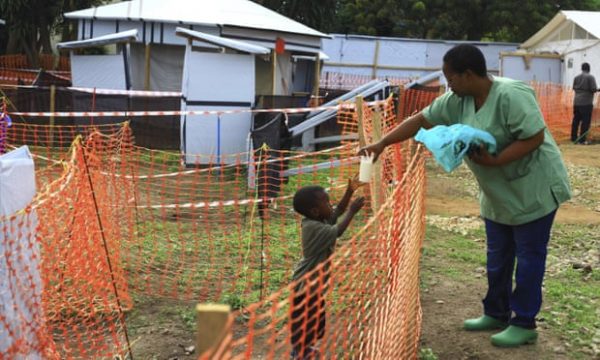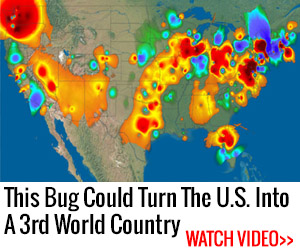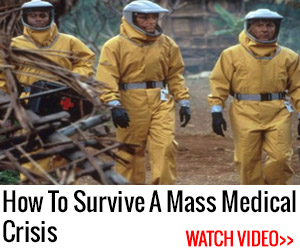Email: tschuckman@aol.com
Good Day, Friends,
At Matthew chapter 24, verse 7, Jesus Himself mentions that there would be major earthquakes and PESTILENCES in the "Last Days" before His 2nd Coming. I believe that that are about 23 facets to His composite "Sign."
A person is not a 'Dooms Day' fellow to remind others about this special time, but just be aware of it. I admit that I may be repetitive but some folks are zealous for the Word of God, and we have a special love for God and His powerful Son.
I don't think that much was said on Mr. Obama's watch for some goofy reason, but now the USA could be turned into a 3rd world country lack of vision and preparedness! There is also a checklist below of what most people should have on hand at home just in case the worst happens.
Warm Regards,
Tom Schuckman
No One Is Safe: The Ebola Virus Is Back With A Vengeance

Experts say the latest Ebola outbreak could be even more devastating than the one that claimed over 11,000 lives in 2014. So far, the virus sweeping the Democratic Republic of Congo has seized 426 victims, 198 of whom have already died. The disease is spreading all over the country, aided by both the stealing of Ebola-infected corpses from morgues in the name of traditional burial practices (which include excessive handling of and exposure to the bodies) and infected people fleeing hospitals under attack due to the ongoing civil violence.
So, you might say, this is sad, but it’s happening halfway across the world. What does it have to do with the US?
But that’s just it. It could be here already.
On December 29th an unnamed American healthcare worker who’d been exposed to the Ebola virus while caring for infected people in the DRC flew back to the States. She was placed under quarantine for up to two weeks at the University of Nebraska Medical Center in Omaha and has yet to show any symptoms or signs of infection.
While many people will be quick to assume this means we’re in the clear because if anything come of this case, “the government will take care of us”, think again. Frightening as it may be, our avoidance of a nation-wide outbreak the last time the Ebola virus came around was merely pure, unadulterated luck. An accident.
Though it was ignored and covered up in the media (not surprisingly), the US personnel’s mishandling of infected persons and failure to take proper precautions during the 2014 outbreak was atrocious.
When American Patient Zero arrived at a Texas emergency room and announced that he was from Liberia- one of the countries completely overwhelmed by Ebola at the time- he wasn’t even tested for the virus. One of his nurses shortly became the next victim.
The second American nurse to become infected flew on a plane carrying 132 passengers. Five more flights were made in the time it took the CDC to notify the airline.
An American healthcare worker who had been definitively diagnosed was brought back to the US for treatment along with eleven ‘potentially infected’ people. Their ‘quarantine facilities’? Hotels. Hotels ‘near’ three different hospitals spread across three different regions of the country.
As usual, truth is stranger than fiction. The fact that our country somehow evaded utter devastation (despite certain officials’ best efforts, it would seem) was nothing short of a miracle. We couldn’t dream to be so lucky this time.
What is Ebola?
Since it’s been a while since any media outlet has covered the dangers of the Ebola virus (don’t think that’s an accident) let’s cover the basics. Ebola is a hemorrhagic virus that kills an average of 50% of its victims. It’s contracted through direct physical contact with an infected person’s bodily fluids and has an incubation period of 2-21 days. The virus becomes contagious with the presence of symptoms, which come in two phases.
Phase one symptoms include fatigue, headache, sore throat, muscle pain, and fever. Phase two symptoms consist of diarrhea, vomiting, rash, signs of impaired kidney and/or liver function, and even internal/external bleeding (discharging from the gums, passing in the stool). Through medical testing, you may discover low white blood cell and platelet counts and a high level of liver enzymes.
What Should You Do?
If the Ebola pandemic does land on US soil, isolation is your only option. Your best chance of keeping your loved ones safe and healthy is to keep them as far away as possible from any potentially infectious place or person. (While it may be impossible to avoid every single risk, remember that any minuscule exception could mean the difference between life and death.)
Lizzie Bennett, a retired medical professional, recommends a 100 mile “buffer zone” between you and the rest of the infected or potentially infected population.
The length of your isolation will depend on your geographic location. The time is shorter for those in rural areas where there’s less human contact and longer for those in congested or highly-populated areas where there’s more human contact and the possibility of people moving around and spreading disease.
Though when you choose to pack up and leave society is up to you, Bennett claims the safest course of action is to stay behind locked doors for two weeks after the last reported case within the 100 mile zone. If you can stay inside longer, you should. It’s always possible there are new cases you didn’t hear about, or that outsiders migrated to your area and started a second wave of infection.
Where to Start
Select your safe house and prepare it. Stock up on all the necessary supplies: food, water, sanitation equipment, etc. and base your lists and amounts on how many people will be staying with you. Be prepared to not set foot outside for at least six weeks. Of all your planning, this is the cardinal rule: no one goes out, no one comes in. Below are three important questions you need to consider when developing your game plan:
-
- If you’re planning with a prepper group (people outside your core circle) will you all shelter together, or separately?
- What events and proximity will trigger lockdown mode?
-
- Will you have a secondary location in case someone within your group gets sick?
In the same vein as the ‘no coming no going’ rule, it’s possible someone (likely a friend or a family member) could show up at your safehouse wanting to join you. As any latecomers are likely carriers of infection, your doors- once shut- should remain so no matter what. However, if you decide to allow them to stay, don’t let them inside until they’ve undergone at least a four week quarantine in a separate building.
Whether you have a newcomer or someone in your group becomes sick, a completely separate quarantine construction will be absolutely necessary (if it’s the latter case, you may have to make use of the room of the house the infected person was already inhabiting, as it’s already contaminated). Here are some requirements to properly prepare and make use of the quarantine area:
Caretakers must be covered head to toe with disposable materials (gowns, gloves, masks) whenever inside the quarantined areas and must remove them before entering back into the safehouse.
(If the area is a room in the house) Use double tarping to section off the room and provide a space in between tarps for caretakers to shed potentially contaminated clothing, gloves, masks, etc.
The quarantined person must use disposable dishes and utensils. Only remove trash/waste from the room inside a heavy-duty garbage bag and burn it immediately.
If the room/building doesn’t have immediate access to a toilet, make other provisions and take extreme precautions in waste-disposal. Under no circumstances can the sick person leave the room/building or use common areas.
Basic Supplies to Stock Up On:
- Paper sanitation supplies (toilet paper, feminine products)
- Bleach
- Spray cleaners, disposable wipes
- Hand sanitizer
- Heavy-duty garbage bags
- First-aid kit
- Nitrile gloves
- N100 face masks (just N95 isn’t enough)
- Drinking water (1 gallon per person per day)
- Food (preferably items that don’t require fuel to prepare)
- Safety goggles with elastic bands
- Pandemic kits that include protective clothing
You’re never going to receive timely or ‘fair’ warnings from the government or the media before these things hit; they don’t want to cause a panic. You’ll hear the occasional mention of ‘something’ happening ‘somewhere’, and then disaster will strike, seemingly out of nowhere.
Well, this is your warning. Now is the time to act. This virus could engulf our country like a wildfire, and by the time people start talking about it, it’ll be too late.









No comments:
Post a Comment